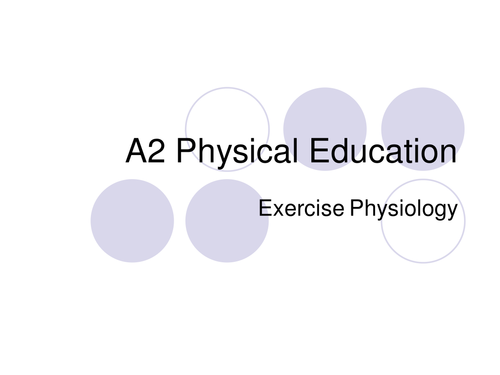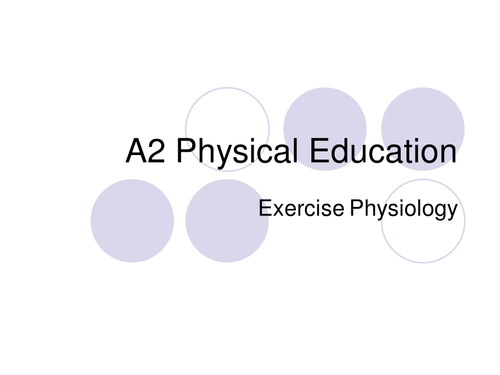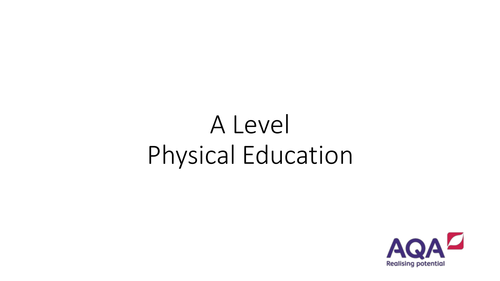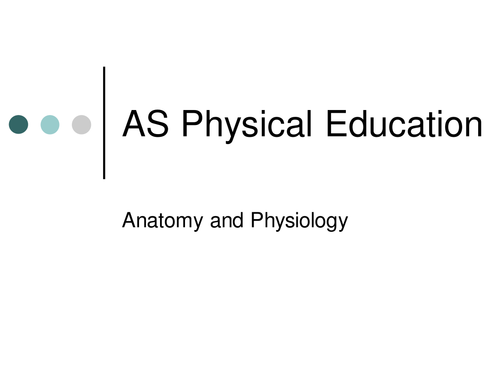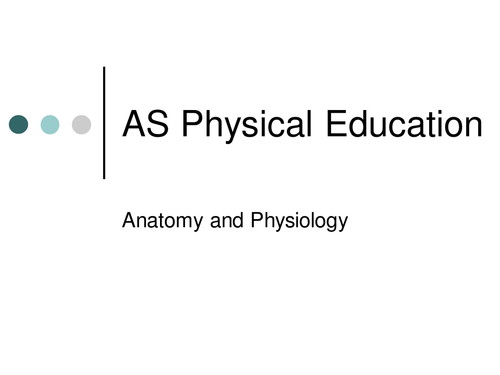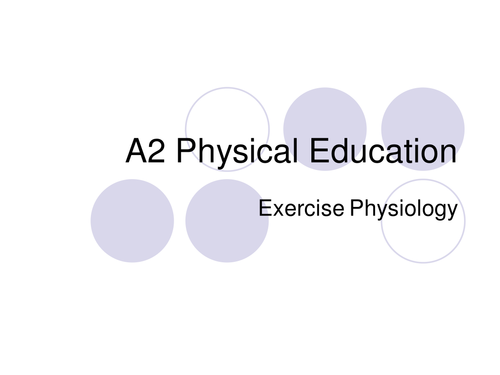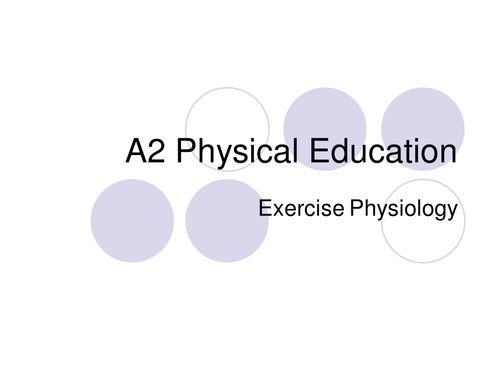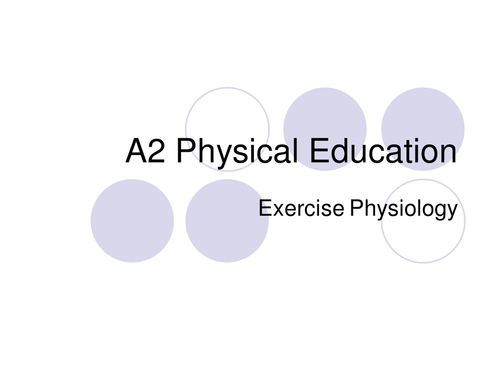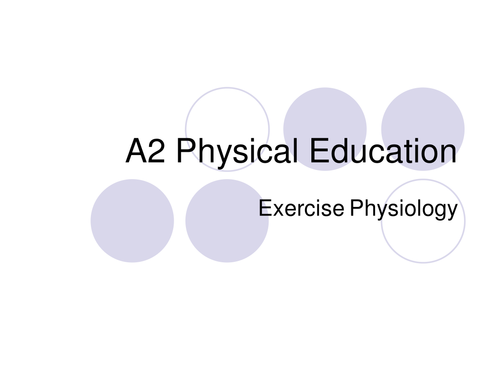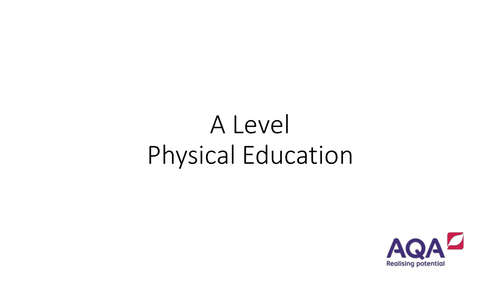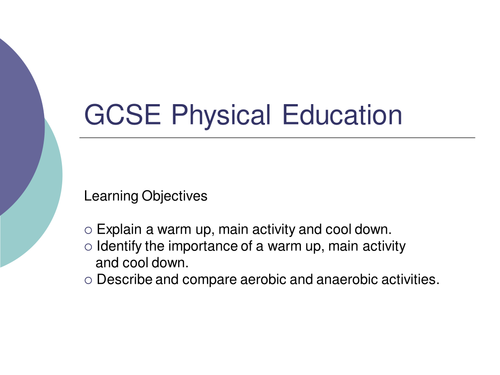
118Uploads
38k+Views
5k+Downloads
Physical education
Sale

A Level PE - Recovery Process
A Level Exercise Physiology lesson. Learning objectives:
- Explain how the body returns to its pre-exercise state.
- Identify the alactacid and lactacid debt components.
- Discuss the implications of recovery for training sessions.
Sale

A level PE - Energy Systems & ATP
A Level Exercise Physiology lesson. Learning objectives:
- Describe the breakdown and re-synthesis of ATP.
- Introduce the three energy systems used to supply ATP to working muscles.
- Explain how duration and intensity of exercise for relates to each energy systems.
Sale

A Level PE - Movements of Joints
A Level Anatomy and Physiology lesson. Learning objectives:
- Identify the anatomical position.
- Introduce anatomical terms of location.
- Discuss the joint actions possible at synovial joints.
Sale

A Level PE - Movement Analysis
A Level Anatomy and Physiology lesson. Learning objectives:
- Recap the types of movement possible at joints.
- Relate these types of movement to physical activity.
- Complete a full movement analysis of a discrete skill.
Sale

A level PE - Heart Conduction System and Cardiac Cycles
A Level Anatomy and Physiology lesson. Learning objectives:
- Provide an overview of the Conduction System.
- Describe how the heart works as a dual action pump (Cardiac Cycle, diastole and systole).
- Describe the link between the Cardiac Cycle and the Conduction System of the heart.
Sale

A Level PE, Sport Psychology, Aggression
Learning Objectives
Identify and describe the four different theories of aggression
Understand the difference between aggression and assertion and link to different theories.
Be able to justify and evaluate the different aggression theories, linking ways to prevent/limit aggression.
Sale

A Level PE - Sport England's Relationship with Local and National Partners to Increase Participation
Learning Objectives
Identify the inter-relationship between Sport England and their local partners through County Sports Partnerships.
Research how the Yorkshire County Sports Partnership is working to increase participation in the local area.
Identify the inter-relationship between Sport England’s national partners who increase participation for under-represented groups.
Sale

GCSE PE - Risk Assessment and Preventing Injuries
A GCSE Physical Education lesson on the Risk Assessment and Preventing Injuries. This is based on the Edexcel exam board. Learning Objectives:
- Identify the risks associated with participation in physical activities.
- Understand the term ‘balanced competition’.
- Identify the importance of playing to the rules of competition.
Sale

A level PE - Muscular Contractions
A Level Anatomy and Physiology lesson. Learning objectives:
- Identify the different types of Muscular Contraction.
- Relate these types of Muscular Contraction to physical activity.
- Perform a number of exercises which utilise the different types of Muscular Contraction.
Sale

A Level PE - Control of Breathing
A Level Anatomy and Physiology lesson. Learning objectives:
- Describe the ventilatory response to light, moderate and heavy exercise.
- Explain how breathing is controlled through the use of the Respiratory Control Centre.
Sale

A level PE - The Mechanics of Breathing
A Level Anatomy and Physiology lesson. Learning objectives:
- Describe the mechanics of breathing at rest and the respiratory muscles involved.
- Explain the changes in the mechanics of breathing during physical activity.
- Introduce respiratory volumes at rest and during exercise.
Sale

(Ginger) Beer Pong Revision Activity
This activity requires a table tennis ball and 18 plastic cups numbered 1-18 on the bottom. One side of cups 1-9 are the list of topics whilst the other half of cups set up on the opposite side of the table are types of revision activities.
Split the group in two and then the each play beer pong until a topic and revision method is selected through the game. This game can be used for any topic or subject.
Sale

A Level PE - Flexibility One
A Level Exercise Physiology lesson. Learning objectives:
- Define and discus static flexibility and dynamic flexibility.
- Describe the factors that affect flexibility.
- Identify the factors which affect flexibility.
Sale

A Level PE - Strength One
A Level Exercise Physiology lesson. Learning objectives:
- Define the different types of strength and identify the factors that affect strength.
- Describe the methods of evaluating each type of strength.
- Evaluate the different types of training used to develop strength.
Sale

A Level PE - Aerobic Capacity Two
A Level Exercise Physiology lesson. Learning objectives:
- Describe different types of training used to develop aerobic capacity.
- Explain the energy system and the foods fuels used during aerobic work.
- Detail the physiological adaptations that take place after prolonged periods of aerobic physical activity.
Sale

A Level PE - Flexibility Two
A Level Exercise Physiology lesson. Learning objectives:
Identify the methods of evaluating flexibility.
Describe different types of flexibility training.
Explain the physiological adaptations that take place after prolonged periods of physical activity.
Sale

A Level PE - Body Composition One
A Level Exercise Physiology lesson. Learning objectives:
- Explain what is meant by body composition.
- Describe the different methods of assessing body composition.
- Complete a Skinfold Calliper Experiment.
Sale

A Level PE - Industrial and Post Industrial 1780-1900 Recreation
A Level Physical Education Skill Acquisition lesson. Learning Objectives:
- Understand how sport changed to reflect a changing society during the Industrial Revolution.
- Identify the characteristics of rational recreation.
- Relate the characteristics of early industrial Britain to the characteristics of rational recreation.
Sale

GCSE PE - Warm Up, Cool Down & Aerobic and Anaerobic Activities
Learning Objectives:
- Explain a warm up, main activity and cool down.
- Identify the importance of a warm up, main activity and cool down.
- Describe and compare aerobic and anaerobic activities.
Sale

A Level PE - The Olympic Games
Learning Objectives:
- The History of the Olympic Games.
- The commercialisation of the Olympic Games.
- The IOC & BOA.

